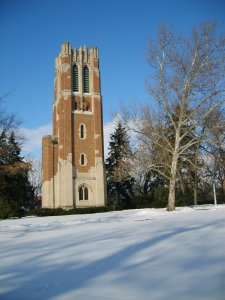
Last December I wrote about the Department of Energy’s (DOE) selection of Michigan State University (MSU) as the site of the Facility for Rare Isotope Beams (FRIB, pronounced F-Rib). FRIB is a next generation nuclear physics facility that will study topics such as nuclear structure and the processes by which stars created the elements. The primary aim of the research is to learn more about the nucleus of the atoms, the origin of the elements, and the evolution of the universe.
-Last week, just in time for the NSCL open house, MSU and DOE signed an agreement for the construction of FRIB.
Story Here
To understand what FRIB does, you need to know something about the atom. Atoms are composed of a nucleus of protons and neutrons (except for the one version of hydrogen which lacks neutrons and perhaps a short lived version of lithium which also lacks neutrons) and a ‘cloud’ of electrons. FRIB will study the proton and neutron nucleus. Elements are defined by the number of protons in a nucleus, so carbon always has 6 protons, oxygen always 8, uranium always 92. Most elements have many possible isotopes, defined by the number of neutrons, so carbon 12 is carbon with 6 protons and 6 neutrons , but there is also a carbon 11 with 5 neutrons and carbon 13 with 7 neutrons and even a very short lived carbon 22 with 16 neutrons. The short lived nuclei like carbon 22 are what FRIB will use in their research. Hence the term rare isotope.
While nuclear physics brings to mind bombs and power plants, the field involves much more. Among other things, nuclear physics has contributed to advances in the detection and treatment of cancer. In fact some large hospitals have their own nuclear medicine research groups.
If you want to learn more about FRIB and nuclear physics in general, watch alpinekat’s newest video-the Rare Isotope Rap. Best known for the Large Hadron Rap which became a youtube phenomena, alpinekat’s newest video brings her back to MSU-her undergrad institution. As former NSCL employee and Science Theatre collaborator of Katie, I was fortunate enough to have the chance to help with this video. I’m a backup dancer…so you know it’ll be funny. But it’s also quite educational.
Video
To learn more about FRIB visit its website.
Picture Source: MSU, FRIB, http://news.msu.edu/media/photo/2008/12/bd79a94b-d887-450f-b859-6a1ee3f492fd.jpg

